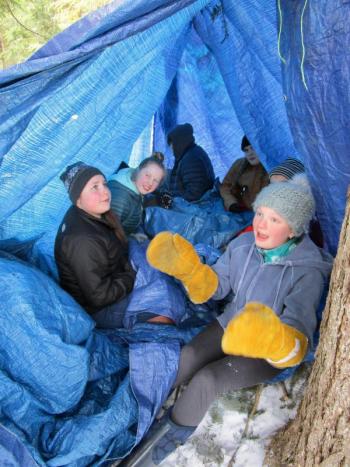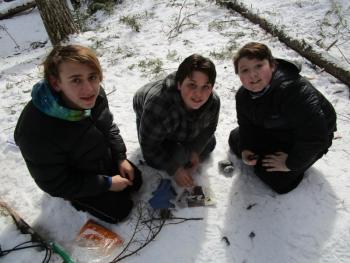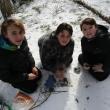WMHS seventh graders take to the outdoors
 In a survival tent of their own making are, from left, Wiscasset Middle High School seventh graders Kaitlyn Talbert, Emily Gilliam and Sadie Yeaton. PHIL DI VECE/Wiscasset Newspaper
In a survival tent of their own making are, from left, Wiscasset Middle High School seventh graders Kaitlyn Talbert, Emily Gilliam and Sadie Yeaton. PHIL DI VECE/Wiscasset Newspaper
 Making a campfire are, from left, seventh graders Isiah Warren, Damon Lincoln and Gage Claypool. PHIL DI VECE/Wiscasset Newspaper
Making a campfire are, from left, seventh graders Isiah Warren, Damon Lincoln and Gage Claypool. PHIL DI VECE/Wiscasset Newspaper
 Warming up are, from left, Makenna Campbell, Sadie Barrett and Delia Trott. PHIL DI VECE/Wiscasset Newspaper
Warming up are, from left, Makenna Campbell, Sadie Barrett and Delia Trott. PHIL DI VECE/Wiscasset Newspaper
 Making a fire on the snow using a striking tool (or steel wool and a battery) is tricky business. It takes patience, dry tinder, a good spark and some luck. PHIL DI VECE/Wiscasset Newspaper
Making a fire on the snow using a striking tool (or steel wool and a battery) is tricky business. It takes patience, dry tinder, a good spark and some luck. PHIL DI VECE/Wiscasset Newspaper
 In a survival tent of their own making are, from left, Wiscasset Middle High School seventh graders Kaitlyn Talbert, Emily Gilliam and Sadie Yeaton. PHIL DI VECE/Wiscasset Newspaper
In a survival tent of their own making are, from left, Wiscasset Middle High School seventh graders Kaitlyn Talbert, Emily Gilliam and Sadie Yeaton. PHIL DI VECE/Wiscasset Newspaper
 Making a campfire are, from left, seventh graders Isiah Warren, Damon Lincoln and Gage Claypool. PHIL DI VECE/Wiscasset Newspaper
Making a campfire are, from left, seventh graders Isiah Warren, Damon Lincoln and Gage Claypool. PHIL DI VECE/Wiscasset Newspaper
 Warming up are, from left, Makenna Campbell, Sadie Barrett and Delia Trott. PHIL DI VECE/Wiscasset Newspaper
Warming up are, from left, Makenna Campbell, Sadie Barrett and Delia Trott. PHIL DI VECE/Wiscasset Newspaper
 Making a fire on the snow using a striking tool (or steel wool and a battery) is tricky business. It takes patience, dry tinder, a good spark and some luck. PHIL DI VECE/Wiscasset Newspaper
Making a fire on the snow using a striking tool (or steel wool and a battery) is tricky business. It takes patience, dry tinder, a good spark and some luck. PHIL DI VECE/Wiscasset Newspaper
It was a sunny but brrr, cold 14 degrees March 7 when seventh graders at Wiscasset Middle High School followed their teachers over a twisting snow-packed trail into Sortwell Forest.
The morning’s classroom was the open air beside a rustic yurt. It was a five-minute trek from Wiscasset Community Center but trudging over six to eight inches of snow made the walk a bit challenging. Lesson one was remembering to wear proper winter footwear including heavy socks. A heavy winter coat and dressing in layers with hats and mittens was a good idea, too.
“It’s the second year we’ve headed outdoors to do this learning exercise as part of our unit on Jack London’s story, "To Build a Fire,” explained Jake McCarthy.
McCarthy teaches English and language arts at WMHS. The lesson included making a campfire without using matches, building a shelter and learning other survival skills including how to get an injured person safely out of the woods.
“It wasn’t anywhere near this cold (for this) last year,” added McCarthy. It’s hard to believe the first day of spring is just two weeks away! The breeze blowing in from the northwest made it feel like six degrees.
That’s balmy compared to the frigid day in the 1890s that London describes in "To Build a Fire" when the mercury plunged to minus-75 in the frozen wilderness of the Canadian Yukon.
The 28 students making up the seventh grade were divided into two groups, then split into smaller teams of four or five. One group worked building a campfire; the second to make a shelter from whatever was handy. Luckily, someone remembered to carry along a roll of duct tape.
McCarthy said that before embarking outdoors, his students discussed the unfortunate man in the story who serves as London’s main character in "To Build a Fire." They talked about his decision-making, why it wasn’t very sound and more importantly how this is relevant to them. The protagonist ignores sound advice and ventures out alone with just a dog for company in the middle of winter. Sadly, he’s woefully unprepared for what happens.
“The lesson is pretty simple; the decisions you make can have serious consequences in your life,” said McCarthy.
Helping McCarthy were science teacher Heather Sinclair, special education instructor Brion Controvillas, Jason Drake, a Jobs for Maine graduate teacher, and educational technician Liz Howard.
Controvillas said it was gratifying to watch the students working together in teams. “For some of the students being outdoors in this type of setting gives them their chance to really shine and show what they can do.”
The lesson included an interesting fact sheet offering tips on what to do and not do if someday they become lost in the wilderness. One suggestion is to avoid venturing into the woods alone; 58 percent of lost hikers are hiking solo. Included too, were instructions for making emergency snowshoes by tying pine boughs to your boots. The best thing of course is to be smart and not get lost in the woods.
After the two and a half hour class, the students headed back to school to warm up.
Answering questions later via email, McCarthy said: "I think it went very well. The day was cold but beautiful. I saw the kids really embracing the cold and getting into the activities we had planned for them. My favorite part of this project is seeing them work through the discomfort of cold toes and fingers and not letting that stop them from learning and I saw a lot of that this morning.
"We spent the afternoon doing some reflective writing and discussions about the lesson and nearly all of the kids had positive things to say. When we do outdoor learning days like this kids and teachers alike seem to really enjoy it."
Event Date
Address
United States




























